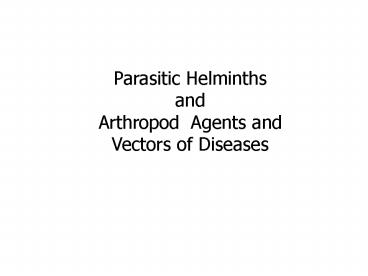Photo Album - PowerPoint PPT Presentation
Title:
Photo Album
Description:
Parasitic Helminths and Arthropod Agents and Vectors of Diseases Parasitic Helminths and Arthropod Agents and Vectors of Diseases Objectives: By the end of this ... – PowerPoint PPT presentation
Number of Views:113
Avg rating:3.0/5.0
Title: Photo Album
1
Parasitic Helminths and Arthropod Agents and
Vectors of Diseases
2
Parasitic Helminths and Arthropod Agents and
Vectors of Diseases
- Objectives
- By the end of this lecture the student should be
able to - Name the three main groups of parasitic helminths
and their characteristic morphological features
. - Describe the life cycle of Ascaris lumbricoides
as an example of parasitic heminths . - Discuss the role of arthropods as agents and as
vectors of diseases in humans. - Give examples of the main arthropod vectors of
diseases.
3
Classification of Parasites
Helminths Protozoa
Mulicellular Specialized cells Unicellular Single cell for all function
Round worms (Nematodes) cylindrical, unsegmented Flat worms 1-Trematodes leaf-like, unsegmented. 2-Cestodes tape-like, segmented Amoebae move by psudobodia. Flagellates move by flagella. Ciliates move by cilia Apicomplexa (sporozoa) Tissue parasites
4
- Location of helminths in the body
- Intestinal helminths
- Tissue helminths
5
- Nematodes
- General features
- Elongated worm, cylindrical, unsegmented and
tapering at both ends. - Variable in size, measure lt1 cm to about 100cm.
- Sex separate and male is smaller than female
6
Ascaris lumbricoides
(roundworm)
7
Ascaris lumbricoides
(roundworm)
- The commonest human helminthes infection.
- Found in jejunum and upper part of ileum.
- Female 20 cm longer than male 10 cm
- Feed on semi digested food.
8
Ascaris lumbricoides
9
The Trematodes
10
Taenia saginata Example of a tapeworm
11
MEDICAL IMPORTANCE OF ARTHROPODS
- 1)As aetiologic agents (causes) of diseases.
- Tissue damage
- Induction of hypersensitivity reactions.
- Injection of poisons
- Entomophobia (acarophobia)
- 2) As vectors of diseases
- I Mechanical transmission - simple carriage
of pathogens. - II Biological transmission
- - cyclical
- - propagative
- - cyclopropagative
- III Transovarian transmission
12
Scabies
13
Scabies
14
(No Transcript)
15
Important arthropod vectors for human diseases
House fly (Musca domestica) Mechanical transmission of many viruses, bacteria and parasites.
Mosquitoes ?????? Anopheles malaria filariasis Culex filariasis, viruses Aedes yellow fever, dengue fever, Rift Valley Fever
Lice ????? Body louse vector for Relapsing fever, typhus and trench fever.
Fleas ???????? Rat flea is vector for plague due to Yersinia pestis.
Ticks ?????? Soft ticks , some are vestors for Borrela duttoni Hard ticks Include vectors for Babesiosis (protozoa), Q fever, and Rocky mountain spotted fever
Tse tse fly (Glossina) ????? ????? Vector for African Trynanosomiasis (African sleeping sickness)
Black fly (Simulium)??????? ??????? Vector for Onchocerca (river blindness)
Sand fly (Phlebotomus) ????? ????? Vectors for leishmania and sandfly fever virus.
Cyclops Vector for Dracunculus medinensis
16
LICE
Louse(singular) , Lice (pleural)
Pediculus humanus
17
Mosquitoes
Cosmopolitan , more than 3000 species. Larval and
pupal stages always aquatic Mouth parts in female
adapted to piercing and sucking blood. Genus and
species distinguished by morphology of adult and
deveopmetal stages.
18
Phlebotomus ( sand fly)

